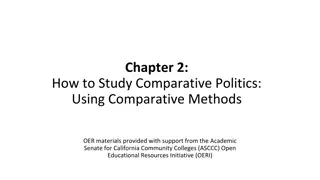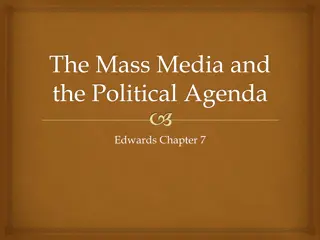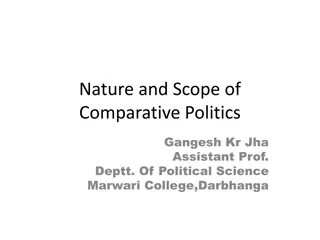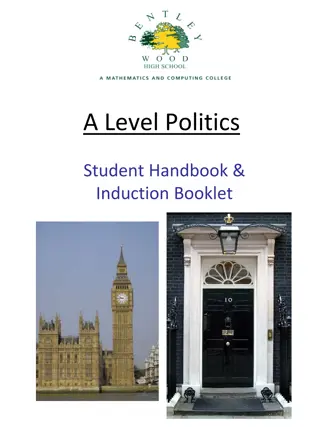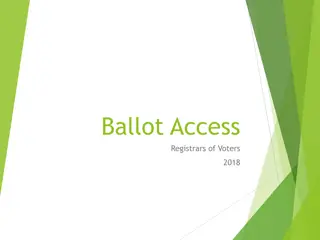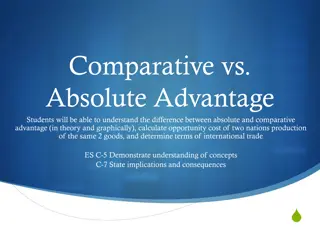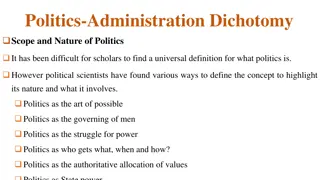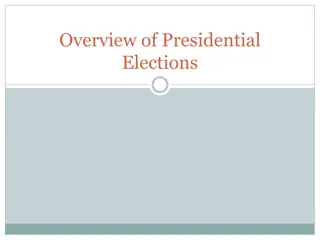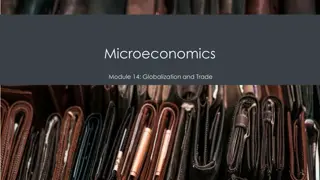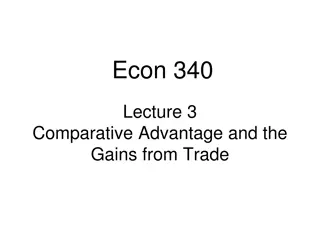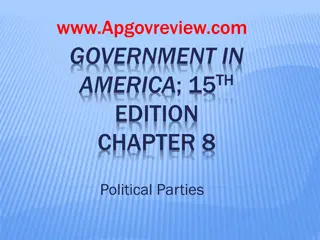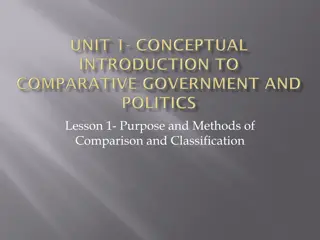Understanding Party Systems in Comparative Politics
Parties in comparative politics play a crucial role in deepening democracy, connecting political society with the State, and maintaining accountability. The definition of a party can be categorized based on normative, motivational behavior, and operational perspectives. The development of party systems is influenced by theories such as social cleavage theory and Duverger's sociological law theory, explaining the formation of parties and party systems.
Download Presentation

Please find below an Image/Link to download the presentation.
The content on the website is provided AS IS for your information and personal use only. It may not be sold, licensed, or shared on other websites without obtaining consent from the author. Download presentation by click this link. If you encounter any issues during the download, it is possible that the publisher has removed the file from their server.
E N D
Presentation Transcript
Why Study Parties in Comparative Politics? Parties are the product of democracy and mass franchise. They are the storehouses of power and help deepening democracy by democratizing polity and spreading democratic values among citizens. The political parties democratize polity by organizing, coordinating and collocating political actors and issues. The parties present in a polity are responsible for maintaining a responsible executive and accountability of the elected members to the people. They play an important role in connecting the politicalsociety with the State: The actors in the political society find space within parties to manipulate the government to act in their favour.
Defining Party Definition of party can be clubbed into the following three categories. 1. Normative: Burke provides the normative definition for whom Party is a body of man united, for promoting by their joint endeavours the national interest, upon some particular principle in which they are all agreed (Burke 1948). 2. Motivational behaviour: The motivational aspect has been dealt by Anthony Downs who defines the party in terms of specific objectives and differentiates between voteseeking , officeseeking and policy- seeking parties. The vote-seeking approach defines party as a team of men seeking to control the government apparatus by gaining office in a duly constituted election (Downs 1957, 25). 3. Operational: This definition examines the party s internal functioning as the key area to understand party behaviour and goals. Important writers in this genre are Katz and Mair (1995), and Maor (1992). They define parties as institutions. Differences between parties are established in terms of patterns of internal management of parties and the way party managers run the party.
Development of Party Systems There are mainly two theories on development of party systems: Social cleavage theory (Lipset and Rokkan 1967) and sociological law theory (Duverger 1963). Lipset and Rokkan Following the Parsonian social stratification model with conceptual AGIL paradigm where A stands for Adaptation, G stands for Goal, I stands for Integration and L stands for Latency in social system theory Lipset and Rokkan have developed the inventory of social and political cleavages in society leading to the formation of party systems. They explain the social bases where the parties drew their strength from. Their three- fold theory analyses state that nation-building when penetrates into the local level finds territorial resistance. The local resistances produce a variety of alliances among and across the communities of the nation (Lipset and Rokkan 1967, 9). In the third phase, these resistances get channelized into the formation of parties. The crystalization of parties led to the formation of party system depending on the alliances among forces. Duverger This law has been famously called Duverger s Law. Duverger proposes one law and another hypothesis. Duverger s law states, The simple majority single-ballot system favors the two-party systems. Of all the hypotheses in this book, this approaches most nearly perhaps to a true sociological law ( Duverger 1963, 217). The hypothesis is the single-majority system with second ballot and proportional representation favours multi- partyism (Duverger 1963, 239).
Party Systems and Characteristics of The pattern of relationship that is present among different parties constitutes a system only if it is characterized by stability and a degree of orderliness . Based on the orderliness we can have the following party systems: One party, one party dominant, two party and multiparty systems. One-party systems: o There exists other parties but a single party has monopoly over power at the expense of other parties. o It excludes all other parties from power. In this sense it is a party system: Parties are present but do not match the monopolistic power of the single party. Differences between one-party system and one-party state: One-party system is different from the one-party state . One-party states have a single party that represents the whole of society. It assumes that only one social interest is supreme in politics and is the unified will of the people. If party system is an interaction between different units, then single-party system is a system where the citizens, party and state machinery become a single body. The party s interest gets entrenched in the state machinery by virtue of controlling the electorate through various means. The states where one-party rules by capturing state machinery is called a one- party state and their units are seen as fused party-state apparatus .
One-Party Dominant System Kenneth J. Green has provided a working definition of the one-party dominant system as hybrids that combine meaningful electoral competition with continuous executive and legislative rule by a single party (Green 2007, 12). Pempel (1990) has mentioned four characteristics of a one-party dominant system: 1. In a dominant party system, the dominant party may have the lowest share of votes in comparison to other parties but has the largest number of seat share in comparison to plurality of parties present in a given political system. 2. The opposition parties may have the largest vote share but cannot form the government because of the strategic position that the dominant party enjoys in the polity. Sometimes, the opposition parties find it difficult to form government without the help of the dominant party. 3. The dominance of one party continues for a long period. 4. The party has a vision of a historicalproject and a political agenda for its achievement (Pempel 1990, 3 4). One-party dominant system is different from the authoritarian form of government in that the one-party dominant system strives within what Green calls meaningful electoral competition (Greene 2007, 12ff, cited in Haren 2010, 3), whereas the authoritarian regimes, especially the closed authoritarian regimes , neither have meaningful election where other parties contest nor do they have opposition parties of any kind (Haren 2010, 3). For them, election is just a procedure to maintain the tag of democracy.
Two-Party System There are a number of small parties present, but only two parties enjoy enough electoral and legislative strength to have the real prospect for winning the election and forming government. The largest party basically on the basis of legislature strength rules and the other party forms the opposition. Power alternates between the two parties as both retain the capacity to be elected alternately or what is termed as government in the wings (Heywood 2013, 236).
Multiparty System There are a number of small parties present, but only two parties enjoy enough electoral and legislative strength to have the real prospect for winning the election and forming government. The largest party basically on the basis of legislature strength rules and the other party forms the opposition. Power alternates between two parties as both retain the capacity to be elected alternately or what is termed as government in the wings (Heywood 2013, 236). Within the two-party systems there are variations. In Britain the two- party system was present between 1945 and 1964. Thereafter came a big lull to the two-party systems. As Hicks (1933) suggests, in America, the two-party systems have the following tenets, first, is the tenet of originality that is two-party system is inscribed into the electoral system of America. Second is the tenet of immutability (Hicks 1933, cited in Disch, 2007, 5), that is, it is the bedrock of democracy that is unmoved by partisan contest.... immune to politics it is timeless and unchanging (Disch 2007, 5) .
Multiparty Systems Multiparty system polity is: characterized by the presence of more than two parties. The small parties can coexist along with the big parties through coalitions and electoral arrangements. There are small parties within the coalition that restricts the bigger party to come to power. The empirical evidence does not support the nomenclature of what constitutes multiparty system. In Germany, for example, it can be called as two-and half- party system as CDU and SDP have equal strength but they are forced to work with small democratic parties as coalition partners (Heywood 2013, 264).
Types of Political Parties Classification of parties is based on a wide variety of criteria and it is difficult to accommodate all parties in the world following a definitive classificatory framework. Basis of classification is always a heuristic device. According to Duverger, parties can be divided on the basis of structural organizational set-up. Depending on the party s behaviour and preferences one can distinguish among policy-seeking, vote-seeking and office-seeking parties. Many a time the typologies ignore the parties in the Third World and pack all of them within the prevailing classificatory schema. For instance, there is hardly any answer to the question on how one is supposed to categorize the Islamic parties those have come up recently in many Islamic countries? Nevertheless, literature on classification have divided parties into the types as follows.
Mass-based Parties a. Openness based on political achievements: The appeal to the masses and opening up for the people with their achievement rather than ascription. b. The capacity for abstraction for stable identification: The masses identify the party as an abstract image that outlives the concrete individual and leaders of the party. It binds people and leaders on its own logic of inertia . c. Extensive organization to manage the masses: The mass parties are organizationalparties . It has sizable permanent and bureaucratic staffing and extensive organizational structure to manage people of various shades. d. A relatively large following: The label massparty definitely involves a quantitative element in that it has thousands of followers. It brings along with it not only the influential people and those who represent special interest but also any citizen who is ready to join the party. The mass parties can derive direct as well as indirect membership.
Cadre-based Parties According to Koole, the following are the main characteristics of the cadre parties: Predominance of professional leadership: The cadre-based parties are basically dominated by the committed set of activists who work whole time for the party. The parties recruit them and make them permanent members who are highly accountable to the lower rung of party leaders and workers. Lower level of voting member s ratio: In contrast to the mass-based party which has a high level of voter and member ratio, the cadre-based party has a low member/voter ratio. The members are important for mobilizing funds for meeting party expenditures, recruiting candidates for offices and different bodies to help party to remain functional. Broad-ranging orientation to voters: The cadre-based parties have strong orientation to the voters. Their strategy is not to become a catch-all-party nor are they interested in focusing classe gardee , that is, specific social-class. Vertical organization with internal democracy: The cadre parties maintain the structure of the mass parties by retaining vertical organizational structure but it maintains a specific image of the party by making it internally democratic. It relies for financial resources on a combination of donations from the members and public (Koole 1994, cited in Wolinetz 2002, 5).
Revolutionary Parties These parties do not follow the constitutional path to come to power. They believe in underground and clandestine activities of a revolutionary nature. They rely on highly motivated cadres to mobilize and recruit the local population. They also have a hierarchical structure which is more centralized in organizing their party activities. The core committee in the party discusses what plans would be carried out. This is followed by the other sub-committees which are set up at different local units. They use clandestine plots to destabilize the government. Sometimes they use disruptive activities to show the powerlessness of the government that helps to mobilize the masses and cadres. Their propaganda and campaign is conducted by well-organized ideological wings and writings. The resources are mobilized through contributions of local units present in both rural and urban areas. The revolutionary parties such as Communist Parties of Marxist and Leninist in India is one such example.
Catch-all Parties Kirchheimer (1966) has provided the following characteristics of the catch- all parties: Parties do not carry much of ideologicalbaggage . The strength of leadership is judged on the basis of how they contribute to efficient functioning of the whole social system. They do not identify goals to be achieved for the organization. There is the obscuring of the role of the individual party member. Playing down of the role of the class-gard e , that is a specific social- class and recruiting voters from population across the territory. Increasing access given to various interest groups for financial support during elections.
Other Bases of Classification Gunther and Diamond (2003, 173) though classified parties into 15 varieties, they provide three criteria for classification of parties across the world. They are: Formalorganization Programatic commitments The strategy that the parties adopts to promote values in society and control behavior of party members Accordingly, they have divided parties into 15 different species . They have borrowed from biology and defined party organization as genus , that encompasses several species of political parties. The five genera are: Elite-based parties Mass-based parties Ethnicity-based parties Electoralist-parties Movement-parties They have categorized the Islamist party within the fundamentalist party, which for Saleem (2014) is highly contentious. Saleem states that Islam is not a monolithic religion. There is nothing called the Islam , rather there are many Islams . For Saleem, it is difficult to distinguish between an Islamist party and other parties only on the basis of a pledge of allegiance to Islam or Islamic principles or Shariah (Saleem 2014, 1). He questions the rationale of defining political parties that could not accommodate parties of the Islamic countries, for instance, Salafis or Global Islamist or Muslim Brotherhood which spans across the national boundaries of the Muslim world.
Conclusion The nature of the parties and party systems is undergoing tremendous change in the neo-liberal era. The bases of the traditional parties are shifting as there is movement of people across the world. The stable two- party system is giving way to multiparty system in some established democracies because of transformed social and political situations. It remains to be seen what shape the party system would take once European Union witnesses the Brexit. In many postcolonial countries, different kinds of party systems are evolving. The party system is changing from regional to national, ethnic to regionalization, and from clientelistic to programmatic. There has been a major shift in the nature of representative form of government in established democracies recently. Some of the matured and established democratic countries such as the United States of America, Brazil and India, are witnessing electoralauthoritarianism , where the party leaders are being elected by manipulating the established electoral practices and illiberaldemocracy , where the leaders after getting elected are suppressing minorities of all hues (Slater 2018). In this situation, it remains to be seen what would be the nature of the parties and party systems in matured, established and fledgling representative democracies across the world.




